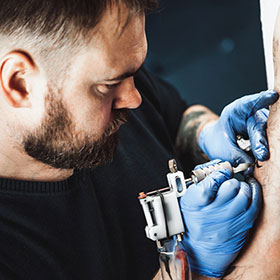Yes, ear tattoos hurt. The pain level varies by person.
Getting a tattoo on your ear involves puncturing sensitive skin with needles. This can be uncomfortable and painful. The ear has many nerve endings, making it a sensitive area. Pain tolerance differs for everyone, so experiences vary. Some people describe ear tattoo pain as sharp and intense, while others find it more bearable.
The pain can also depend on the size and complexity of the tattoo design. Smaller, simpler tattoos might hurt less than larger, more detailed ones. In this blog, we’ll explore the pain associated with ear tattoos and share some tips to manage it. Understanding what to expect can help you decide if an ear tattoo is right for you.
Introduction To Ear Tattoos
Ear tattoos have become a rising trend in the tattoo world. Many people find them unique and stylish. These tattoos can be small and delicate. They offer a way to express oneself creatively. The ear provides a perfect canvas for tiny, intricate designs.
One reason for their popularity is their unique placement. Ear tattoos can be easily hidden or shown off. This makes them versatile for different occasions. Some people prefer ear tattoos because they are less common than other placements. They give a sense of individuality.
Pain Factors
Everyone feels pain differently. Some people have high pain tolerance. They might feel little discomfort. Others have low pain tolerance. They may find it very painful. It depends on your body’s reaction. Try to relax. Tension can increase pain.
A skilled tattoo artist makes a big difference. They know how to reduce pain. They work fast and steady. An experienced artist uses the needle with care. This can make the process easier. Always choose a professional. They ensure a better experience.
Comparing Ear Pain To Other Areas
Ear tattoos can hurt more than arm tattoos. The skin on the ear is thinner. There are more nerve endings. The pain may feel sharper. Arm tattoos feel like scratches. The skin on the arm is thicker. There are fewer nerve endings. Pain is less intense.
Back tattoos usually hurt less than ear tattoos. The back has more muscle and fat. This helps cushion the pain. The ear has little protection. Pain feels direct and sharp. Back tattoos may feel like a dull ache. Ear tattoos feel sharp and quick.
Different Parts Of The Ear
The ear lobe is the soft, fleshy part. Tattoos on the lobe can be less painful. Many find it bearable. The lobe has fewer nerves. Pain levels are lower here.
The helix is the curved outer edge. Tattoos on the helix can hurt more. The skin is thinner. Nerves are more sensitive. Pain can be sharp or intense. Some find it uncomfortable.
The tragus is the small bump near the ear canal. Tattoos on the tragus are quite painful. This area is thick and tough. Many nerves are present here. Pain can be intense and sharp. Consider this before getting a tragus tattoo.
Pain Management Techniques
Topical anesthetics can help reduce pain during ear tattoos. These creams numb the skin. Apply them before the tattoo session. Wait for them to work. They make the process more comfortable. Use them as directed by a professional. Always ask your tattoo artist first. Not all creams are safe for tattoos. Choose one recommended by experts. This will ensure safety and effectiveness.
Breathing exercises can help manage pain. Breathe in deeply. Hold your breath for a few seconds. Exhale slowly. Repeat this process. It helps calm your nerves. Focus on your breathing. It can distract from the pain. Practice this before your tattoo session. It will be easier during the tattooing. Many people find this very helpful. It’s a simple technique anyone can try.
Aftercare Importance
Ear tattoos need special care. Keep the area clean and dry. Use a gentle soap. Rinse with warm water. Pat dry with a clean towel. Do not rub. Avoid touching the tattoo with dirty hands. Use a clean cloth to remove any dirt. Repeat twice a day.
The healing process is crucial. Your ear tattoo may scab. Do not pick at it. Let it heal naturally. Apply a thin layer of ointment. Use a recommended product. Avoid sun exposure. Keep your tattoo covered. Wear a hat or use sunscreen. Stay away from pools. Chlorine can harm your tattoo. Be patient. Healing takes time.
Personal Experiences
Many people share their stories about ear tattoos. Some say they feel a sharp pain. Others find it more like a sting or pinch. Pain levels can vary a lot.
Anna, who has a small ear tattoo, says it hurt less than expected. Mark, on the other hand, felt a lot of discomfort. He says it was more painful than his arm tattoo.
Tattoo artists often discuss ear tattoos with their clients. They explain that the pain depends on the person’s pain threshold. Some clients feel minimal pain. Others may feel significant discomfort.
Artists also note that ear tattoos require precision. The skin is thin and sensitive. This can add to the pain. Choosing an experienced artist can help ease the process. They use techniques to minimize discomfort.
Final Thoughts
Getting an ear tattoo can be a unique choice. The pain level is different for everyone. Some might feel a lot of pain. Others may not. The ear has many nerves. This makes it more sensitive. Think about your pain tolerance. Also, consider how visible it is. Ear tattoos are hard to hide. This can affect jobs or other situations.
Think about the aftercare. Ears can be tricky to clean. You must follow the artist’s advice. This helps avoid infections. Ear tattoos can fade quickly. The skin is thin there. Touch-ups might be needed. This means more pain and cost.
Weigh the pros and cons. Speak with a tattoo artist. Make sure it’s the right choice for you. Ear tattoos are a big decision. Think it through. Choose wisely.
Conclusion
Ear tattoos can be painful, but experiences vary. Pain depends on placement and individual tolerance. Proper aftercare helps minimize discomfort and promotes healing. Consulting with a professional artist ensures a safe and satisfying experience. Considering all factors, ear tattoos can be worth it for many.
Be prepared and informed before getting one. Your unique style can shine through, even with a little pain.

